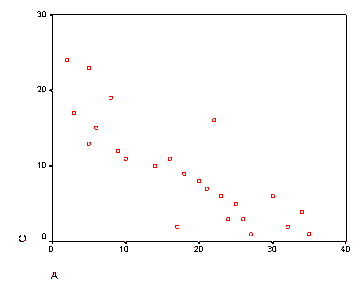4.E: Describing Bivariate Data (Exercises)
- Page ID
- 2333
General Questions
Q1
Describe the relationship between variables \(A\) and \(C\). Think of things these variables could represent in real life. (relevant section)

Q2
Make up a data set with \(10\) numbers that has a positive correlation. (relevant section & relevant section)
Q3
Make up a data set with \(10\) numbers that has a negative correlation. (relevant section & relevant section)
Q4
If the correlation between weight (in pounds) and height (in feet) is \(0.58\), find: (relevant section)
- the correlation between weight (in pounds) and height (in yards)
- the correlation between weight (in kilograms) and height (in meters)
Q5
Would you expect the correlation between High School GPA and College GPA to be higher when taken from your entire high school class or when taken from only the top \(20\) students? Why? (relevant section)
Q6
For a certain class, the relationship between the amount of time spent studying and the test grade earned was examined. It was determined that as the amount of time they studied increased, so did their grades. Is this a positive or negative association? (relevant section)
Q7
For this same class, the relationship between the amount of time spent studying and the amount of time spent socializing per week was also examined. It was determined that the more hours they spent studying, the fewer hours they spent socializing. Is this a positive or negative association? (relevant section)
Q8
For the following data: (relevant section)
| A | B |
| 2 | 8 |
| 5 | 5 |
| 6 | 2 |
| 8 | 4 |
| 9 | 1 |
- Find the deviation scores for Variable \(A\) that correspond to the raw scores of \(2\) and \(8\).
- Find the deviation scores for Variable \(B\) that correspond to the raw scores of \(5\) and \(4\).
- Just from looking at these scores, do you think these variable \(A\) and \(B\) are positively or negatively correlated? Why?
- Now calculate the correlation. Were you right?
Q9
Students took two parts of a test, each worth \(50\) points. Part \(A\) has a variance of \(25\), and Part B has a variance of \(36\). The correlation between the test scores is \(0.8\).
- If the teacher adds the grades of the two parts together to form a final test grade, what would the variance of the final test grades be?
- What would the variance of Part \(A\) - Part \(B\) be? (relevant section)
Q10
True/False: The correlation in real life between height and weight is \(r=1\). (relevant section)
Q11
True/False: It is possible for variables to have \(r=0\) but still have a strong association. (relevant section & relevant section)
Q12
True/False: Two variables with a correlation of \(0.3\) have a stronger linear relationship than two variables with a correlation of \(-0.7\). (relevant section)
Q13
True/False: After polling a certain group of people, researchers found a \(0.5\) correlation between the number of car accidents per year and the driver's age. This means that older people get in more accidents. (relevant section)
Q14
True/False: The correlation between \(R \) and \(T\) is the same as the correlation between \(T\) and \(R\). (relevant section)
Q15
True/False: To examine bivariate data graphically, the best choice is two side by side histograms. (relevant section)
Q16
True/False: A correlation of \(r=1.2\) is not possible. (relevant section)
Questions from Case Studies
The following questions are from the Angry Moods (AM) case study.
Q17
(AM#21) What is the correlation between the Control-In and Control-Out scores? (relevant section)
Q18
(AM#22) Would you expect the correlation between the Anger-Out and Control-Out scores to be positive or negative? Compute this correlation. (relevant section & relevant section)
The following question is from the Flatulence (F) case study.
Q19
(F#4) Is there a relationship between the number of male siblings and embarrassment in front of romantic interests? Create a scatterplot and compute r. (relevant section & relevant section)
The following questions are from the Stroop (S) case study.
Q20
(S#6) Create a scatterplot showing "colors" on the \(Y\)-axis and "words" on the \(X\)-axis. (relevant section)
Q21
(S#7) Compute the correlation between "colors" and "words." (relevant section)
Q22
Sort the data by color-naming time. Choose only the \(20\) fastest color-namers and create a scatterplot. (relevant section)
- What is the new correlation? (relevant section)
- What is the technical term for the finding that this correlation is smaller than the correlation for the full dataset? (relevant section)
The following question is from the Animal Research (AR) case study.
Q23
(AR#11) What is the overall correlation between the belief that animal research is wrong and belief that animal research is necessary? (relevant section)
The following question is from the ADHD Treatment (AT) case study.
Q24
(AT#8) What is the correlation between the participants' correct number of responses after taking the placebo and their correct number of responses after taking \(0.60\) mg/kg of MPH? (relevant section)
Select Answers
S4
- \(0.58\)
S8
- \(-4, 2\)
S9
- \(109\)
S17
\(r = 0.72\)
S19
\(r = -0.30\)
(larger numbers for the "romint" variable mean less embarrassment)
S21
\(r = 0.70\)


